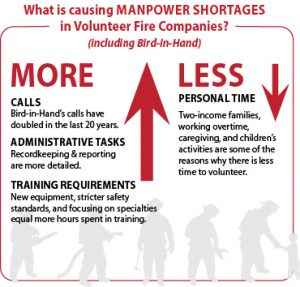According to the Philadelphia Inquirer, Pennsylvania had 300,000 volunteer firefighters in the mid–1970s. Last year that number was down to 72,000 — more than a 75 percent drop, according to state officials. Unfortunately, fire companies in Lancaster County are not immune to this manpower shortage. Our own Bird-in-Hand Fire Company is creatively exploring ways to work at the human resources issue.
The Fire Company is up to the challenge of maintaining a strong crew of skilled firefighters for future years. We proved our ability to cope with change several years ago when we faced financial constraints in our organization. At that time we met the fiscal challenges head on, and found viable solutions. We did that by setting new goals, such as eliminating debt, paying all purchases in cash, and involving the whole community in our fundraising efforts. The results have been awesome!
Now it is time to study multiple ways to ensure that our community has plenty of well-trained volunteer firefighters with capable leadership to protect the next generations. The state fire commissioner estimates statewide, Pennsylvania taxpayers would pay about $10 billion per year to replace volunteers with paid firefighters. Thus, it is in everyone’s best interests to fill the ranks of volunteer firefighters in our communities.
This leaves the Fire Company with a dilemma. Either the current membership has to do more or additional volunteers are needed so that the tasks can be spread among more people. New active firefighters are always welcome, along with members who take on supportive roles. These supportive roles, as simple as driving our firefighters to their classes a couple evenings each week or helping with property maintenance at the station once a month, free up firefighters for training and responding to calls.
We know that people love to volunteer with organizations that have clear goals, are well run, and have good systems in place. We need to build structures in our Fire Company so that we use our members’ strengths, skills, and limited time as efficiently as possible.
Here are several new suggestions to consider that can help to avoid burnout and overwork:
- Establish duty crews: Certain volunteers schedule their work and free time so they can commit to answering calls on certain days.
- Volunteers only respond to calls that require their skill sets.
- Time spent in training should match the learning style of the volunteer: One-on-one training, reading course books, online courses, courses at the training center, or training sessions at our Fire Hall.
- Volunteers should not have to repeat training that they have already accomplished just so a group of trainees can stay together. Training needs to be more individually paced, such as the one-room schoolhouse model where members within a group are working on different levels.
 The most urgent need is leadership. Yes, we need firefighters who know how to do their jobs, but we also need leaders who can determine which jobs need to be done when. Now is the time to identify leadership qualities in our young firefighters and mentor them for these roles. Finding solutions for this “leadership strain” is an upfront investment that will pay big dividends in years to come.
The most urgent need is leadership. Yes, we need firefighters who know how to do their jobs, but we also need leaders who can determine which jobs need to be done when. Now is the time to identify leadership qualities in our young firefighters and mentor them for these roles. Finding solutions for this “leadership strain” is an upfront investment that will pay big dividends in years to come.
The Human Resource Committee* has identified three steps to make membership numbers sustainable.
- Recruitment and retention
- Skills and knowledge
- Organization and response
New patterns in all of these areas are essential for operating the Fire Company successfully in the future.
The goal of the HR Committee is to provide sufficient manpower: to have enough people power to respond to emergency situations in our community for the entire 21st century. Just as we found that the financial goal of operating in the black was attainable, the Fire Company has confidence that the goal of sustainable membership is also within reach.
In conclusion, ninety percent of the activities and departments of the Fire Company are going well. But in the remaining ten percent, we have this gap:
Your fire company is short on help.
Even though we have a strong group of junior firefighters and three brand-new firefighters were recently voted in, now is the time to address this dilemma. If we do not change, there is a leadership vacuum looming ahead. What is very much needed is leadership that works well together. We have to realize that things are not the same as they were 20 years ago, thus we need to build new human resource structures.
By making you, our community residents, aware of what the issues are and by presenting some probable strategies, we hope you will come alongside of us as we work to find solutions. We want Fire Company volunteers to know that they are on a winning team!
* The Human Resource Committee includes Tim Hoerner, Paul Fisher, Lavelle Beiler, Ivan Stoltzfus, Melvin B. Stoltzfus, Dan J. Fisher, Ben Beiler, Sam King, Lonnie Kauffman, Steve Petersheim, David Riehl, Norm Decker, Jake Blank, Jacob B. Stoltzfus, Don Boyer, Ephraim Stoltzfus, Mark Beiler, Andrew Beiler, and Mannie Glick.

